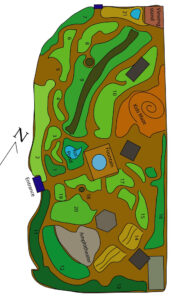The Keystone Heritage Park History
Keystone Heritage Park is an archeological site, an archaic wetlands and a botanical garden. The 58-acre park in El Paso’s Upper Valley is a City-owned property leased to a volunteer Board of Directors who are charged with preserving and developing the Park.
The Archeological Site was first discovered in the late 1970s by the Corps of Engineers during the construction of flood control dams. Runoff from a thunderstorm washed away the bank of a shallow arroyo revealing a cut-away of an ancient pit house. Preliminary research revealed the hut was part of a larger village. Carbon dating indicated the site was 4000+ years old. According to National Geographic Magazine, it may be one of the largest and oldest villages of its kind in the United States.
Keystone Wetlands is home to many species of birds and is a stop on a migratory route for even more. Over 250 species of birds have been spotted there, including 22 species considered rare by the Audubon Society. These archaic wetlands depict the wetlands that once lined the Rio Grande.
The botanical garden at Keystone is a project adopted by the Junior League of El Paso in the year 2000. In 2003, the Rotary Club of El Paso committed to building Phase Two of the garden. The garden encompasses features such as a Xeric demonstration garden, a children’s garden, an amphitheater, a moonlight garden, an ethno-botanical garden and more. This garden represents an approximate $1.2 million investment in our community and is the result of donations and volunteer work by individuals and businesses on both sides of our border. The garden is available for events such as weddings, reunions and corporate gatherings. Please call 915-490-8571 for information.
The history of Keystone Heritage Park began in 1997 with the formation of the Keystone Archeological Preservation and Protection Association. By 1999, there were more than 300 members and the project was broadened to include the archeological site. In 1999, the Keystone organization was born. At first a project of the El Paso Community Foundation, Keystone obtained its own designation as a not-for-profit organization in 2000.
In 2000, Keystone Heritage Park volunteers convinced the City of El Paso to sponsor them in applying for a Texas Highway Department highway beautification grant (TEA-21). KHP prepared the grant proposal and with some lobbying managed to win a grant for approximately $1.4 million to purchase and preserve land bordering the wetlands that were eventually donated to KHP. By late 2002, the land was acquired, all transfers made and the city of El Paso entered into a 30 year lease with KHP for the management and development of the park.
Keystone Heritage Park is an IRS approved 501(c)(3) organization with a board of directors composed of community leaders and volunteers. The Keystone board is diligently working to assure the long-term success of this valuable asset. The extensive involvement of other community organizations, such as the Rotary Club, the Junior League, the Audubon Society, the Texas Master Naturalists, numerous boy scout troops and more, demonstrate the community’s commitment to the success of the project.
Future Plans
Keystone Heritage Park (KHP) is actively shaping its future, beginning with the Chihuahuan Desert Experience (CDE). This ten-acre expansion will transport visitors through the entire Chihuahuan Desert, from its southern origins near Mexico City to its northern stretches in New Mexico, building on our current wetland bird views and natural desert vegetation.
Crucially, we’re advancing the development of our archaeological site. A recent professional synthesis guides our next step: ground-penetrating radar. This will precisely locate the estimated forty-plus structures that represent the earliest known inhabitation of the area.
Our Board and dedicated volunteers are committed to transforming KHP into an internationally recognized park, a testament to the archaeology, anthropology, and deep heritage of our Rio Grande location.
